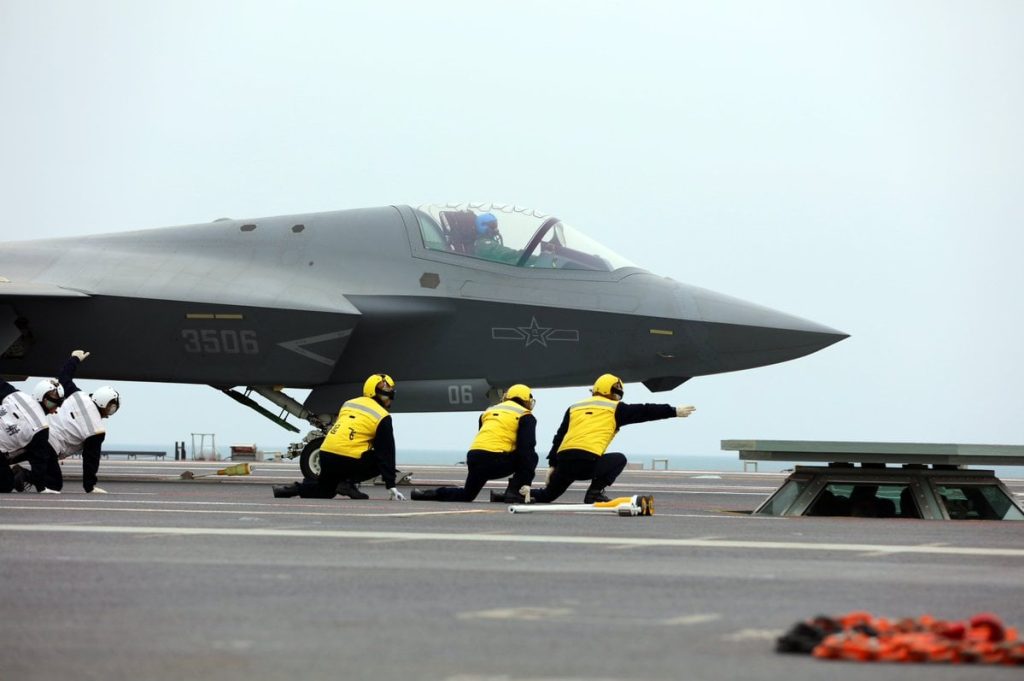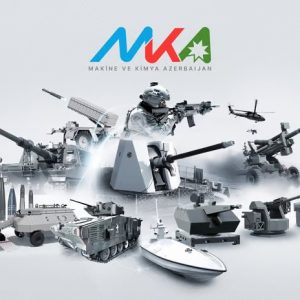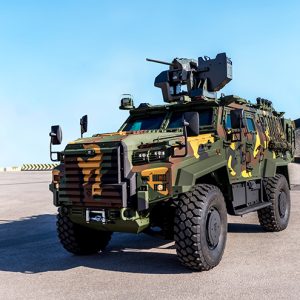Lead: China’s third carrier Fujian (Type 003) has publicly conducted CATOBAR trials with the J‑35 stealth fighter, J‑15T multirole jet and KJ‑600 AEW\&C. This is the first released sequence that shows launch, recovery and deck handling together. The milestone signals that the Fujian aircraft carrier J-35 pairing is moving from isolated clips to integrated carrier aviation.
The People’s Liberation Army Navy (PLAN) released footage from Fujian (18) during the ship’s ninth sea trial. The video confirms electromagnetic catapult launches and arrested recoveries across three fixed‑wing types. Until now, only the U.S. Navy fielded this full set of capabilities. Consequently, the PLAN has crossed an important threshold in deck aviation.
Why CATOBAR on Fujian matters
CATOBAR enables heavier launch weights, higher sortie rates and better endurance. In practice, stealth fighters lift with more internal fuel and weapons. In parallel, the KJ‑600 can launch with the electrical power and fuel needed for long orbits. Therefore, the Fujian aircraft carrier J-35 combination unlocks a true detect‑classify‑engage loop at range.
The release also aligns with Fujian’s ninth sea trial and a recent Taiwan Strait transit. Timing suggests confidence. Next comes integrated work‑ups and night operations. If reliability holds, commissioning can follow.
The air wing: what we know now
J‑35 (twin‑engine stealth): Launch and recovery look routine in clean configuration. The key questions now shift to tempo. Can crews turn jets quickly in higher sea states? Can maintainers keep the jet available with reasonable man‑hours per flight hour? Those answers will decide operational value.
J‑15T (catapult‑capable Flanker derivative): The type fits standoff strike, maritime air superiority and jamming roles. CATOBAR allows higher bring‑back weights. That means fewer forced jettisons and more flexible tasking.
KJ‑600 (AEW\&C): This is the decisive addition. Fixed‑wing AEW\&C extends radar horizon and enables battle management similar to the U.S. E‑2 series. With a catapult, the KJ‑600 can depart heavy and stay on station. As a result, fighter control and cooperative targeting improve dramatically.
What remains unproven? Day‑night cyclic operations in rougher seas. Deck density at scale, often cited at around 40 aircraft. Electromagnetic catapult reliability under high tempo. And finally, datalink integration and emissions control in contested electromagnetic conditions. These are routine hurdles for a new carrier air wing.
Regional balance: carriers proliferate
Beijing’s public CATOBAR moment lands amid parallel moves by regional powers. India is bringing Rafale‑M to sea on Vikrant. Japan is converting the Izumo class for F‑35B operations, with trials advancing in phases. Indonesia is exploring the acquisition of the ex‑Italian Giuseppe Garibaldi, with proposals to convert it into a drone‑forward mothership that could support Bayraktar‑class UAVs. Together, these steps widen sea‑based aviation across the Indo‑Pacific.
The strategic effect is clear. A Fujian aircraft carrier J-35 deck group, backed by KJ‑600 and modern escorts, complicates allied planning in the Western Pacific. In response, partners are extending ISR reach, hardening PNT and NAVWAR defenses, and spreading their forces to shorten kill chains while avoiding single‑point failure.
Industrial signal: the enterprise matures
Fujian launched in 2022. Since then, the program has moved through a steady set of sea trials. This first multi‑type public deck sequence sends a deeper message: catapult machinery, arresting gear and aviation support systems have reached a stable integration point. The next milestones are predictable—night ops, foul‑weather launches, and mission‑system validations. If these proceed smoothly, commissioning in the near term is plausible. Ultimately, endurance and maintenance data will govern readiness.
Electromagnetic catapults bring benefits beyond headline speed. They reduce steam plumbing and allow more precise end‑speed control across aircraft types. Precision reduces structural stress and improves launch repeatability. The trade‑offs sit in shipboard power quality and load management. The power architecture must keep the rails stable under combat loads and battle damage.
Implications for NATO and partners
Allies will judge this event by sortie‑generation and AEW\&C persistence, not by video alone. If Fujian aircraft carrier J-35 operations can sustain long‑range combat air patrols and overlapping KJ‑600 orbits, maritime tactics will shift. Expect more passive targeting, further distributed maritime operations, and more aggressive stand‑in electronic attack. Tanking architecture remains an open question for the PLAN and will shape combat radius.
For Turkish industry watchers, Indonesia’s possible Garibaldi conversion—paired with deck‑adapted UAVs—signals fresh demand for launch and recovery aids, deck handling solutions and maritime SATCOM. That creates potential opportunities across the defence and aerospace supply chain.
Technical insight
CATOBAR vs. STOBAR is not simply ramps vs. rails. CATOBAR enables higher launch mass and true fixed‑wing AEW\&C. That combination extends detection and engagement range. STOBAR carriers can fly capable fighters, yet they often lack the heavy payloads and AEW\&C that make a carrier strike group lethal at distance.
Internal link
For certification and airspace deconfliction trends, see our NATO AEP‑107 analysis on sense‑and‑avoid for UAS in shared airspace. It frames how deck‑launched UAVs may achieve approvals in busy maritime corridors.
Key Facts
- Event: Public launches and recoveries of J‑35, J‑15T, KJ‑600 from Fujian using electromagnetic catapults.
- Phase: Aligns with ninth sea trial and Taiwan Strait transit toward South China Sea test areas.
- Shift: First non‑U.S. CATOBAR with a fixed‑wing AEW\&C aircraft in the Indo‑Pacific.
- Region: India’s Rafale‑M path, Japan’s F‑35B carriers, and Indonesia’s carrier exploration.
- Watch: Night and foul‑weather ops, sortie rates, EM‑cat reliability, AEW\&C integration, and tanker support.

Conclusion
The Fujian aircraft carrier J-35 trials are more than optics. They show that China’s carrier aviation is nearing an operational configuration: stealth fighters with useful range and payload, fixed‑wing AEW\&C, and the deck machinery to launch and recover them at tempo. Commissioning will be a calendar note. What matters is whether the PLAN can sustain predictable sortie rates, keep the catapults healthy and knit this deck group into a coherent blue‑water doctrine. Regional navies are already responding.
Further Reading
- Carrier AEW\&C and deck integration: comparative lessons from U.S. Navy E‑2 operations.
- Allied carrier adaptations: Japan’s Izumo/Kaga F‑35B conversion path.
- Indian Ocean balance: India’s Rafale‑M procurement and timelines.
- UAV at sea: Indonesian Garibaldi conversion reporting and TB3 pathways.
References
- USNI News — “Chinese Aircraft Carrier Fujian Launches Stealth Jet, Early Warning Aircraft in Catapult Tests” (22 Sep 2025)
- Xinhua — EM catapult launch capability obtained (22 Sep 2025, item 1); Xinhua — EM catapult arrested recovery capability (22 Sep 2025, item 2)
- AP — Taiwan Strait transit & ninth sea trial context (11–12 Sep 2025); Reuters — transit report (11 Sep 2025)
- Defence Agenda — “NATO AEP‑107 standard refines sense‑and‑avoid for UAS” (22 Sep 2025)
- Breaking Defense — “China shows catapult launches of carrierborne aircraft for the first time” (22 Sep 2025)
- Reuters — India’s Rafale‑M contract coverage (28 Apr 2025)
- Naval News — JS Kaga F‑35B modification updates (Apr 2024)
- USNI News — Japan receives additional F‑35B aircraft (7 Aug 2025)
- AP — Japan deploys first F‑35B fighters (Aug 2025)
- Stars & Stripes — JS Kaga F‑35B trials off Southern California (Nov 2024)
- Reuters — India’s carrier plans and Rafale context (5 Sep 2025)
- Janes — Indonesia financing for Giuseppe Garibaldi (19 Sep 2025)
- Naval News — Indonesia eyes Garibaldi; TB3 angle (21 Jun 2025)
- Zona Militar — financing approval update (19 Sep 2025); Army Recognition — loan approval context (Sep 2025)








